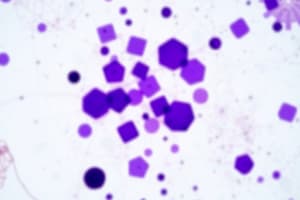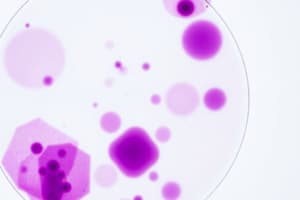Podcast
Questions and Answers
What type of stain is NOT typically used for biopsy specimens?
What type of stain is NOT typically used for biopsy specimens?
- Hemotoxin stain (correct)
- Warthin-Starry stain
- Silver stain
- Giemsa stain
Which culture media is specifically used to isolate non-fermentative gram-negative bacilli?
Which culture media is specifically used to isolate non-fermentative gram-negative bacilli?
- Chocolate agar
- MacConkey agar
- Saline agar
- Brucella agar (correct)
Which of the following characteristics is TRUE about non-fermentative gram-negative bacilli?
Which of the following characteristics is TRUE about non-fermentative gram-negative bacilli?
- They produce acid in TSI agar slant.
- They are typically found as normal flora in humans.
- They are fermentative and oxidase-negative.
- They are often acquired through contaminated food or water. (correct)
Which virulence factor is associated with non-fermentative gram-negative bacilli?
Which virulence factor is associated with non-fermentative gram-negative bacilli?
What pigment is produced by Pseudomonas aeruginosa?
What pigment is produced by Pseudomonas aeruginosa?
Which statement about the biochemical test results of non-fermentative gram-negative bacilli is FALSE?
Which statement about the biochemical test results of non-fermentative gram-negative bacilli is FALSE?
Non-fermentative gram-negative bacilli are associated with which environment?
Non-fermentative gram-negative bacilli are associated with which environment?
Which of the following odors is associated with non-fermentative gram-negative bacilli cultures?
Which of the following odors is associated with non-fermentative gram-negative bacilli cultures?
What type of test shows a positive result for Burkholderia cepacia?
What type of test shows a positive result for Burkholderia cepacia?
Which characteristic of Burkholderia cepacia colonies on BAP is noted?
Which characteristic of Burkholderia cepacia colonies on BAP is noted?
What is the optimum growth temperature range for Burkholderia cepacia?
What is the optimum growth temperature range for Burkholderia cepacia?
On which type of agar does Burkholderia cepacia grow well?
On which type of agar does Burkholderia cepacia grow well?
What type of biochemical reaction does Burkholderia cepacia display?
What type of biochemical reaction does Burkholderia cepacia display?
Which related infection is NOT typically associated with Burkholderia cepacia?
Which related infection is NOT typically associated with Burkholderia cepacia?
What is a common medium for culturing Burkholderia cepacia?
What is a common medium for culturing Burkholderia cepacia?
Which of the following traits is associated with Burkholderia cepacia colonies on MacConkey agar?
Which of the following traits is associated with Burkholderia cepacia colonies on MacConkey agar?
What color is the pigment produced by Pseudomonas aeruginosa on cetrimide agar?
What color is the pigment produced by Pseudomonas aeruginosa on cetrimide agar?
Which of the following statements correctly describes the respiratory characteristics of Acinetobacter?
Which of the following statements correctly describes the respiratory characteristics of Acinetobacter?
What type of infections can Burkholderia cause?
What type of infections can Burkholderia cause?
Which test is used for identifying bacterial susceptibility to specific bacteriophages?
Which test is used for identifying bacterial susceptibility to specific bacteriophages?
What distinguishes P. montelli from P. putida?
What distinguishes P. montelli from P. putida?
What is the appearance of mucoid colonies produced by P. aeruginosa commonly associated with?
What is the appearance of mucoid colonies produced by P. aeruginosa commonly associated with?
Which characteristic is NOT associated with Burkholderia?
Which characteristic is NOT associated with Burkholderia?
Which medium enhances the pigment production of P. aeruginosa?
Which medium enhances the pigment production of P. aeruginosa?
What characteristic pigmentation is associated with Alcaligenes faecalis colonies when cultured?
What characteristic pigmentation is associated with Alcaligenes faecalis colonies when cultured?
Which of the following environments is Alcaligenes faecalis NOT typically isolated from?
Which of the following environments is Alcaligenes faecalis NOT typically isolated from?
Which test result would indicate a non-lactose fermenting organism?
Which test result would indicate a non-lactose fermenting organism?
What is a distinctive feature of the culture of Alcaligenes faecalis on blood agar plates?
What is a distinctive feature of the culture of Alcaligenes faecalis on blood agar plates?
What type of conditions do Haemophilus species require for growth?
What type of conditions do Haemophilus species require for growth?
Which statement about Haemophilus type b is true?
Which statement about Haemophilus type b is true?
What is a biochemical feature of Oligella?
What is a biochemical feature of Oligella?
What describes the microscopic appearance of Alcaligenes faecalis?
What describes the microscopic appearance of Alcaligenes faecalis?
What type of medium is used to determine the oxidative and fermentative metabolism of certain bacteria?
What type of medium is used to determine the oxidative and fermentative metabolism of certain bacteria?
Which clinical condition is primarily associated with Pseudomonas infections?
Which clinical condition is primarily associated with Pseudomonas infections?
What is the result of the TSI reaction for Pseudomonas species as stated in the content?
What is the result of the TSI reaction for Pseudomonas species as stated in the content?
Which biochemical test result indicates Pseudomonas as oxidase positive?
Which biochemical test result indicates Pseudomonas as oxidase positive?
What type of bacteria are Pseudomonas species classified as based on their metabolism?
What type of bacteria are Pseudomonas species classified as based on their metabolism?
At what temperature can Pseudomonas species grow, according to the properties mentioned?
At what temperature can Pseudomonas species grow, according to the properties mentioned?
Which of the following characteristics is NOT associated with Pseudomonas species?
Which of the following characteristics is NOT associated with Pseudomonas species?
Which of these infections is caused by Pseudomonas species as mentioned in the content?
Which of these infections is caused by Pseudomonas species as mentioned in the content?
Flashcards
Warthin-Starry, Silver, and Giemsa stains
Warthin-Starry, Silver, and Giemsa stains
Stains commonly used for visualizing structures in biopsy specimens.
CAP, MTM, Skirrow, Blood, and Brucella agars
CAP, MTM, Skirrow, Blood, and Brucella agars
Agar plates used to culture bacteria, each with specific nutrients and inhibitors to select for certain organisms.
Non-Fermentative Gram-Negative Bacilli
Non-Fermentative Gram-Negative Bacilli
Gram-negative bacilli found in the environment that can cause opportunistic infections, especially in healthcare settings.
Nebulizers, dialysate, saline, soil, hospital surfaces
Nebulizers, dialysate, saline, soil, hospital surfaces
Signup and view all the flashcards
Fruity odor, Motility, Oxidase-positive, NLF
Fruity odor, Motility, Oxidase-positive, NLF
Signup and view all the flashcards
Pyoverdin
Pyoverdin
Signup and view all the flashcards
Pyocyanin
Pyocyanin
Signup and view all the flashcards
Pyorubin
Pyorubin
Signup and view all the flashcards
Pyomelanin
Pyomelanin
Signup and view all the flashcards
Pseudomonas Clinical Significance
Pseudomonas Clinical Significance
Signup and view all the flashcards
TSI Reaction of Pseudomonas
TSI Reaction of Pseudomonas
Signup and view all the flashcards
Oxidative-Fermentative (OF) Medium Result
Oxidative-Fermentative (OF) Medium Result
Signup and view all the flashcards
Distinguishing Characteristics of Pseudomonas
Distinguishing Characteristics of Pseudomonas
Signup and view all the flashcards
Pseudomonas Morphology
Pseudomonas Morphology
Signup and view all the flashcards
Burkholderia
Burkholderia
Signup and view all the flashcards
Burkholderia Biochemical Tests
Burkholderia Biochemical Tests
Signup and view all the flashcards
Alcaligenes fecalis
Alcaligenes fecalis
Signup and view all the flashcards
Flavobacterium, Spiribacterium, and Achromobacter
Flavobacterium, Spiribacterium, and Achromobacter
Signup and view all the flashcards
Haemophilus
Haemophilus
Signup and view all the flashcards
Haemophilus influenzae Type b (Hib)
Haemophilus influenzae Type b (Hib)
Signup and view all the flashcards
Study Notes
Staining Techniques for Biopsy Specimens
- Warthin-Starry, Silver stain, and Giemsa stain are commonly used staining techniques for biopsy specimens.
Culture Media for Bacteriology
- Common culture media include CAP (Chocolate Agar Plate), MTM (Modified Thayer-Martin), Skirrow agar, 5% sheep's blood agar, and Brucella agar.
Non-Fermentative Gram-Negative Bacilli
- Opportunistic pathogens found primarily in the environment; not part of human normal flora.
- Acquired through ingestion of contaminated food, water, or exposure to medical devices.
- Capable of surviving chlorhexidine and quaternary ammonium compounds.
Characteristics and Isolation
- Isolated from sources such as nebulizers, dialysate, saline, soil, and hospital surfaces.
- Exhibit fruity odors reminiscent of grapes or corn tortillas.
- Biochemical characteristics include motility (excluding B. mallei), oxidase-positive, and non-lactose fermenters (NLF).
Pigments Produced
- Pyoverdin: Yellow-green or yellow-brown.
- Pyocyanin: Blue, produced exclusively by P. aeruginosa.
- Pyorubin: Red pigment.
- Pyomelanin: Brown or black pigment.
Clinical Significance
- Pseudomonas species are predominant non-fermenters; responsible for nosocomial respiratory tract infections and Gram-negative bacillary bacteremia.
- Can cause ecthyma gangrenosum, swimmer's ear, and pulmonary infections in cystic fibrosis.
Biochemical Testing
- TSI: Reaction typically K/K or K/N; H2S negative.
- Oxidative-Fermentative (OF) medium shows yellow in open tube (oxidizer) and green/blue-green in closed tube (non-oxidizer).
Distinguishing Characteristics of Pseudomonas
- Obligate aerobes, non-spore formers with polar flagella.
- Grow well on MacConkey agar; commonly isolated as straight, slender Gram-negative rods.
- Morphological characteristics include spreading and flat colonies with bluish-green pigmentation.
Burkholderia
- Includes species such as B. cepacia, B. pseudomallei, and B. mallei, which are non-fermenting, primarily isolated from hospital equipment and irrigation fluids.
- Biochemical tests show catalase positive, oxidase negative reactions, and poor growth on some media.
Alcaligenes fecalis and Other Non-Fermentative Bacilli
- Alcaligenes fecalis is an obligate aerobe with peritrichous flagella; grows on MacConkey agar.
- Other non-fermenters include Flavobacterium, Spiribacterium, and Achromobacter.
Haemophilus Genus
- Derives its name from Greek words meaning "blood lover", existing primarily in the upper respiratory tract.
- Comprised of typeable strains (capsular serotypes a-f, particularly H. influenzae type b linked to severe infections).
Conclusion
- Understanding these key attributes enables effective identification and treatment of infections caused by non-fermentative Gram-negative bacilli and related pathogens.
Studying That Suits You
Use AI to generate personalized quizzes and flashcards to suit your learning preferences.




